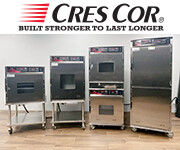College administrators are analyzing all aspects of their operations campus-wide to be more efficient financially and environmentally. Part of the evaluation is on facilities, including domestic hot water (DHW) systems. Administrators must develop a plan to meet hot water demand for students and staff while satisfying the goals of reducing carbon footprint and aligning with stated environmental, social, and governance (ESG) plans.
Facility managers tasked with the assignment of reducing fossil fuel usage while supplying sufficient hot water – even at peak demand – have a balancing act. Electrification and DHW systems designed with high-efficiency equipment are approaches that can help them walk the proverbial tightrope.
Paths of Electrification
Government regulations and corporate ESG strategies are key drivers of converting all facility systems from fossil fuels to electrification. Many federal, state, and local agencies offer rebates and other financial incentives to help manage the cost of converting to electrical systems.
Options abound for methods to convert DHW systems from gas to electricity. The question is, “Which approach balances sustainability and cost efficiency?”
Heat pumps are one solution; however, they generally are the most expensive system in terms of upfront costs. They also require larger footprints to accommodate necessary storage tanks. For these reasons, heat pumps are not viable for many colleges and universities.
Another option is to utilize electric water heaters, which have a lower price tag than heat pumps and generally have the same footprint as gas-fired alternatives. They also reach close to 100% efficiency, higher than many gas-fired water heaters.
Not all electric water heaters are created equal, however. Many electric water heaters have large, high-kilowatt tube bundles. Because all elements are bundled, it can be difficult and expensive to maintain since all elements must be replaced if one fails. Some units, however, such as the one shown in figure 1, are designed with individual heating elements rated at 9kW or 18kW, which are simpler and more cost efficient to maintain, as only the failed elements need to be replaced, not the entire bundle of elements.
Advanced Materials Improve Reliability
As is the case with gas-fired water heaters, reliability is critical for electrical units to prevent unforeseeable costs in the future. Facility managers and school administrators should select water heaters manufactured with high-quality materials to save on lifecycle costs.
Engineered materials that blend austenitic and ferritic steels are used in certain water heaters that make them highly resistant to aqueous corrosion in potable water at any temperature, as well as chloride stress corrosion cracking. The materials also eliminate the need for tank linings or anode rods, reducing maintenance costs over the life of the water heater.
DHW systems should also be designed with low-flow fixtures, efficient hot water distribution systems, and water reuse/recycling systems. They improve system operating efficiency and reduce water consumption for lower utility bills.
Decentralized Systems Meet Cost, Sustainability Goals
A centralized design has been the traditional configuration for domestic hot water (DHW) systems in many campus settings. On today’s campuses, however, a centralized system is usually highly inefficient, raising operating and utility bills in multi-building applications – which most campuses fall under. A much more cost-efficient solution is a decentralized system, whereby each building has its own dedicated DHW system.
One key cost benefit of a decentralized design is that each DHW system is properly sized for the respective building. The inherent inefficiencies associated with an oversized, centralized system are eliminated. Additionally, there are no heat losses associated with hot water having to travel across campus via an underground distribution piping system.
The distribution piping system, a fundamental element of a centralized DHW system, is eliminated by a decentralized system. Financial savings are realized. Pipes crack and leak over time, which decreases system efficiency, resulting in higher energy, water, and sewer costs. School administrators must also allocate budget for repairs and replacement of aging underground pipes.
When designing a decentralized system, decision makers should ensure that it can heat water between 140° – 160°. Having a loop set at higher temperatures is necessary to prevent Legionella and other pathogens. At 122° – 130°, Legionella stops multiplying but it remains in the water. Legionella will die in 32 minutes (on average) when water temperatures are 140°. The bacteria die instantly when water temperatures reach 151°.
Higher temperatures do create a risk of scalding and thermal shock injuries. To protect students, administration, and guests, digital mixing valves need to be designed into the systems (figure 2). They add cold water to the loop so tempered water is output. Mixing valves should control output water temperature within ±2°F per ASSE 1017 standards and can be connected to a Building Automation System (BAS) for remote operation and monitoring.
Proper Sizing and Load Management
To achieve optimal cost efficiencies, decentralized systems must be properly sized for each building on a college campus. Dormitories differ in size and have larger and more variable loads compared to lecture halls and cafeterias. Additionally, water usage is extremely high when school is in session while demand is much lower between semesters. Depending on the student body, weekends may also have less demand than during the week.
For these reasons, proper system sizing and load management are key variables that can often be overlooked. BTU/hour input can be lowered by as much as 10% if high-efficiency condensing water heaters that match existing load are installed rather than mid-efficiency models. As an added benefit, properly sizing the water heater lowers the carbon footprint of the system, serving as a strong complement to electric water heaters.
Technology Lowers Operating Costs
Advanced monitoring and controls add intelligence to electric water heater systems. Facility managers can track water heating performance, water usage, identify inefficiencies, and optimize system performance for cost savings. With buildings spread over a large campus, monitoring tools simplify managing a decentralized system. DHW systems with building automation and control systems for centralized monitoring, scheduling, and optimization of operations maximize efficiency and cost savings.
Value of Certification
One often overlooked criterion in selecting water heaters is if they are American Society of Mechanical Engineers (ASME) certified. Water heaters that have earned ASME certification typically have a greater lifetime value, as they prove to be more reliable and last longer. Additionally, an ASME-certified water heater provides:
- Added Level of Safety – A main benefit of an ASME-rated water heater is higher safety. To earn ASME approval, the water heaters pass rigorous testing to ensure they can withstand the demands of large facilities, such as dormitories, large cafeterias, and other buildings found on campuses.
- High Standards – ASME water heaters often meet higher standards, meaning they better address the demands of continuous operation, for greater reliability.
- Code Compliance – Integrating an ASME-rated water heater into a system better aligns the unit with local codes, aiding the approval process.
Conclusion
The purchase and implementation of the right campus hot-water systems is of paramount importance for college and university administrators tasked with satisfying sustainability initiatives while maintaining cost-efficient DHW systems. Integrating electric water heaters is one piece of the puzzle. To complete the picture, design options such as high-efficiency equipment and conversion to a decentralized system should also be considered. The more administrators know about the factors involved, the more likely they are to reap the benefits of the right systems, materials, and technology for their campus over the long term.
Sharon Cho is a Product Manager for Domestic Hot Water Solutions at PVI, a Watts Brand for light commercial and electric products. She has product management and mechanical engineering experience in a variety of industries.
Helen Ringle is a Product Manager for Domestic Hot Water Solutions at PVI, a Watts Brand for heavy commercial products. She has 14 years’ experience in product engineering and management.










